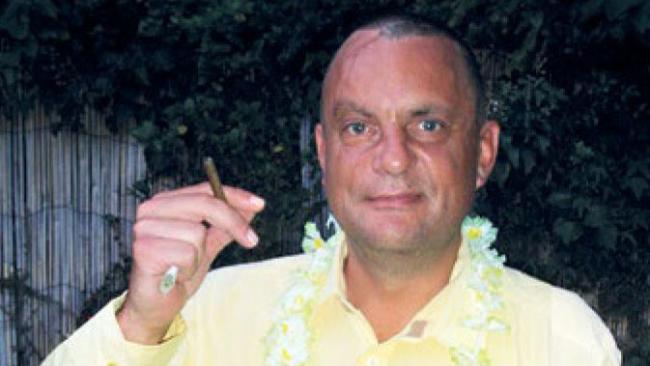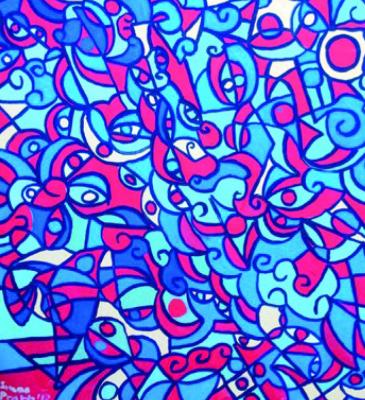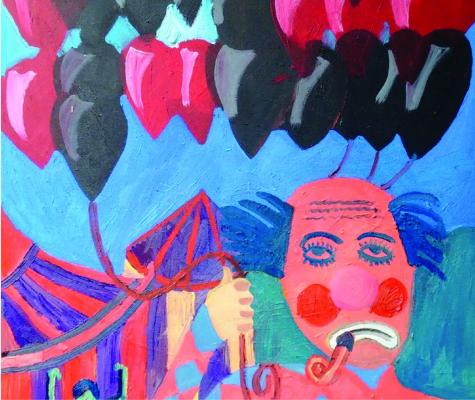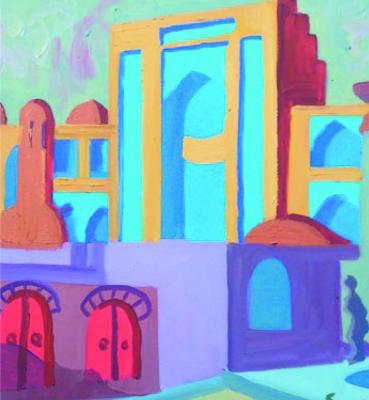
"Art gave me a second chance at life"
Content Warning: suicidal thoughts
After a failed suicide attempt, Jesuan Simon Pratt (Mathematics,1989) learnt to paint with one arm – and took a point off a Wimbledon champion.
Simon's story was published in December 2020 and is reproduced here by kind permission of The Oldie Magazine.
I was a ‘jumper’.
On 7 February 1990, at around 11pm, at Queen’s Park Station on the Bakerloo line, I leapt in front of the approaching train. I was 18 years old. I remained conscious throughout but felt no pain. Afterwards, I told the ambulance crew to tell my parents that ‘I have bumped into a lamppost and, if they believe that, they will believe anything’.
I knew I wanted to live a week before I jumped – it was an epiphany. But I still went ahead. The only thing I can remember now is the surgeon at St Thomas’ Hospital informing me he would have to amputate my left (writing) arm from my shoulder because it had lost its pulse. The train had run over it inches from my neck.
The blow to my forehead was serious. There followed a 10-hour-long operation to fish out the chips of bone that were floating around my brain. I have had a plastic plate inserted in my skull to cover the hole. A patch of skin under my right eye was shredded (amazingly the eye was not harmed) and a skin graft from behind my ear was put in its place. That ear was pinned back as part of the operation – pretty useful, as it did rather stick out.
There were then four days in intensive care, tended by an attractive nurse, who sent me a postcard when she went on holiday abroad some time later. I spent three weeks in a surgical ward. The metal staples were removed from the stump where my arm had been. I immediately felt a ‘phantom limb’. A sensation akin to pins and needles ran down my ‘arm’. This phenomenon exists to this day; it isn’t painful – just irritating.
Then the real crunch came: I was going into the psychiatric unit at the hospital. I had never felt so humiliated. Dad said he was crying inside.
I received a treasure-trove of getwell-soon cards. I was visited by old schoolmates who had not liked me at Westminster School, where I had been a Queen’s Scholar. Friends from the Christian Union to which I belonged at Jesus College, Cambridge, where I was studying mathematics, often came – one of the girls is still my best friend.
Lord Justice Staughton and his wife came (my father was his clerk). Staughton paid me an immense compliment: he said I was the bravest man he had ever met.
Mum was granted compassionate leave by the House of Lords, where she was a Hansard reporter. She popped in all the time. The chaplain and the maths teacher from Westminster were ardent supporters.
I was in the psych ward for six more weeks. I have to admit that, after a period of adjustment, I quite enjoyed the funny farm. I was on a high; I had SURVIVED. There were some real characters inside. I had intensive art therapy, which sorted many issues out.
To this day, the strangest thing of all is that the consultant psychiatrist did not believe I had a mental illness. He insisted I had had a nervous breakdown from overwork at Cambridge. He said I had the emotional maturity of a 13-year-old, and the intellectual age of a 25-year-old. This is despite my telling him a plethora of psychotic delusions and fantasies.
"I see myself as an English artist – not a disabled artist."
- Simon Pratt
It took another seven years, and another serious breakdown, before I was properly diagnosed with severe bipolar disorder and psychosis. I now take a gram of lithium carbonate every morning. It has saved my life.
Dad converted the attic into an artist’s studio for me – he is talented at DIY. I heard him weeping as he worked. All his dreams for me had been destroyed.
So, I started to paint with my right arm. I had been awarded an ‘A’ grade in A-level art at school – so I wasn’t starting from scratch. My first efforts were not good – the main drawback when I paint is that my hand shakes. I cannot achieve the draughtsmanship I wish I had. I enjoy painting large canvases; I can use my whole arm, sweeping over the cotton. When I paint a portrait in particular the eyes are a challenge.
Improvement was gradual: the breakthrough came in 1994 when I was commissioned by the English bridge authorities to paint the card game’s world champion as the Queen of Hearts for the front cover of their magazine.
That was the start of my new life and I have since had many exhibitions. I see myself as an English artist – not a disabled artist.
Dressing was never a problem. I astonished the doctors because I adapted instantly to my disability. I learnt to tie my shoelaces, ski in the Swiss Alps, and serve a tennis ball one-handed. I am a keen member of Acorn Lawn Tennis Club in Edgware. I have taken on the former Wimbledon champion Pat Cash at the Queen’s Club and won a point off his serve. He is still recovering.
Writing was the biggest challenge. It took six months to achieve a rudimentary standard. Even today, it is barely adequate, but now we use keyboards all the time – so it doesn’t matter.
My mum, dad, sister and friends cherished me. I wouldn’t have survived without them. As the Beatles sang, ‘All you need is love’ – and medication.
Visit Simon's website to see some of his art.








